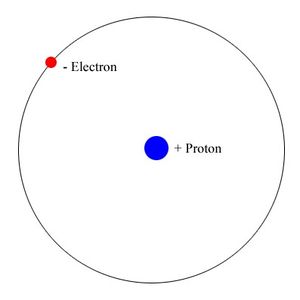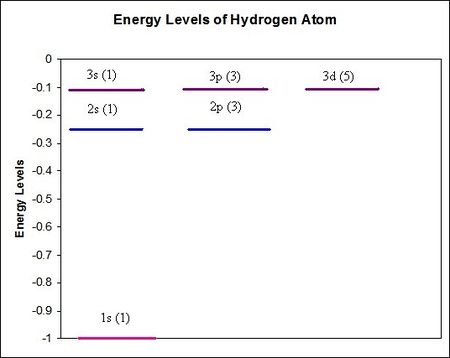Hydrogen Atom: Difference between revisions
No edit summary |
|||
| Line 134: | Line 134: | ||
==Problems== | ==Problems== | ||
[[Phy5645/HydrogenAtomProblem| | |||
'''(1)''' | |||
This problem taken from ''Quantum Mechanics: Concepts and | |||
Applications'' by Nouredine Zettili: Exercise 6.3 | |||
'''An electron in a hydrogen atom is in the energy eigenstate''' <math> | |||
\psi_{2,1,1} \left(r, \theta, \phi \right) = Nre^{-\frac{r} | |||
{2a_o}}Y_{1,-1}\left(\theta, \phi \right)</math>. '''(a) Find the normalization constant, N.''' | |||
[[Phy5645/HydrogenAtomProblem|Solution]] | |||
[[Phy5645/HydrogenAtomProblem3| Problem 2]] | [[Phy5645/HydrogenAtomProblem3| Problem 2]] | ||
Revision as of 23:25, 1 September 2013
We now discuss the solution of the Schrödinger equation for the hydrogen atom. We are especially interested in this system because it is of direct physical interest and because it is possible to solve it exactly.
The effective one-dimensional problem for this system is
Failed to parse (SVG (MathML can be enabled via browser plugin): Invalid response ("Math extension cannot connect to Restbase.") from server "https://wikimedia.org/api/rest_v1/":): {\displaystyle \left[ -\frac{\hbar^2}{2\mu}\frac{d^2}{dr^2}+\frac{\hbar^2}{2\mu}\frac{l(l+1)}{r^2}-\frac{Ze^2}{r}\right] u_{nl}=Eu_{nl},}
where Failed to parse (SVG (MathML can be enabled via browser plugin): Invalid response ("Math extension cannot connect to Restbase.") from server "https://wikimedia.org/api/rest_v1/":): {\displaystyle Z=1\!} represents the hydrogen atom, Failed to parse (SVG (MathML can be enabled via browser plugin): Invalid response ("Math extension cannot connect to Restbase.") from server "https://wikimedia.org/api/rest_v1/":): {\displaystyle Z=2\!} represents the helium ion, Failed to parse (SVG (MathML can be enabled via browser plugin): Invalid response ("Math extension cannot connect to Restbase.") from server "https://wikimedia.org/api/rest_v1/":): {\displaystyle He^+,\!} and so on. Here, Failed to parse (SVG (MathML can be enabled via browser plugin): Invalid response ("Math extension cannot connect to Restbase.") from server "https://wikimedia.org/api/rest_v1/":): {\displaystyle \mu\!} is the effective mass of the atom.
We will focus on the bound states here. To solve the above equation, let us begin by writing down its solutions in the limits of small and large Failed to parse (SVG (MathML can be enabled via browser plugin): Invalid response ("Math extension cannot connect to Restbase.") from server "https://wikimedia.org/api/rest_v1/":): {\displaystyle r\!.}
In the limit of small Failed to parse (SVG (MathML can be enabled via browser plugin): Invalid response ("Math extension cannot connect to Restbase.") from server "https://wikimedia.org/api/rest_v1/":): {\displaystyle r;\!} i.e., Failed to parse (SVG (MathML can be enabled via browser plugin): Invalid response ("Math extension cannot connect to Restbase.") from server "https://wikimedia.org/api/rest_v1/":): {\displaystyle r \to 0,} the equation becomes
Failed to parse (SVG (MathML can be enabled via browser plugin): Invalid response ("Math extension cannot connect to Restbase.") from server "https://wikimedia.org/api/rest_v1/":): {\displaystyle \left[ -\frac{\hbar^2}{2\mu}\frac{d^2}{dr^2}+\frac{\hbar^2}{2\mu}\frac{l(l+1)}{r^2}\right] u_{nl}=0.}
The only solution to this equation that is not divergent as Failed to parse (SVG (MathML can be enabled via browser plugin): Invalid response ("Math extension cannot connect to Restbase.") from server "https://wikimedia.org/api/rest_v1/":): {\displaystyle r\to 0} is Failed to parse (SVG (MathML can be enabled via browser plugin): Invalid response ("Math extension cannot connect to Restbase.") from server "https://wikimedia.org/api/rest_v1/":): {\displaystyle u_{nl}(r)\sim r^{l+1}.\!}
In the opposite limit, Failed to parse (SVG (MathML can be enabled via browser plugin): Invalid response ("Math extension cannot connect to Restbase.") from server "https://wikimedia.org/api/rest_v1/":): {\displaystyle r \to \infty,} we obtain
Failed to parse (SVG (MathML can be enabled via browser plugin): Invalid response ("Math extension cannot connect to Restbase.") from server "https://wikimedia.org/api/rest_v1/":): {\displaystyle \frac{d^2 u_{nl}}{dr^2}+\frac{2\mu E}{\hbar^2}u_{nl}=0.}
The only solution to this equation that does not diverge as Failed to parse (SVG (MathML can be enabled via browser plugin): Invalid response ("Math extension cannot connect to Restbase.") from server "https://wikimedia.org/api/rest_v1/":): {\displaystyle r\to\infty} is Failed to parse (SVG (MathML can be enabled via browser plugin): Invalid response ("Math extension cannot connect to Restbase.") from server "https://wikimedia.org/api/rest_v1/":): {\displaystyle u_{nl}(r)\sim e^{-r/a},\!} where Failed to parse (SVG (MathML can be enabled via browser plugin): Invalid response ("Math extension cannot connect to Restbase.") from server "https://wikimedia.org/api/rest_v1/":): {\displaystyle a=\sqrt{\frac{-\hbar^2}{2\mu E}}.}
Let us now define Failed to parse (SVG (MathML can be enabled via browser plugin): Invalid response ("Math extension cannot connect to Restbase.") from server "https://wikimedia.org/api/rest_v1/":): {\displaystyle \kappa=a^{-1}.\!} The above asymptotic limit for large Failed to parse (SVG (MathML can be enabled via browser plugin): Invalid response ("Math extension cannot connect to Restbase.") from server "https://wikimedia.org/api/rest_v1/":): {\displaystyle r\!} can now be written as
Failed to parse (SVG (MathML can be enabled via browser plugin): Invalid response ("Math extension cannot connect to Restbase.") from server "https://wikimedia.org/api/rest_v1/":): {\displaystyle u_{nl}(r)\sim e^{-\kappa r}.\!}
We now assume that the full expression for Failed to parse (SVG (MathML can be enabled via browser plugin): Invalid response ("Math extension cannot connect to Restbase.") from server "https://wikimedia.org/api/rest_v1/":): {\displaystyle u_{nl}(r)\!} has the form, Failed to parse (SVG (MathML can be enabled via browser plugin): Invalid response ("Math extension cannot connect to Restbase.") from server "https://wikimedia.org/api/rest_v1/":): {\displaystyle u_{nl}(r)=(\kappa r)^{l+1}e^{-\kappa r}W(\kappa r).\!}
To simplify the equation, let us introduce the dimensionless radial coordinate, Failed to parse (SVG (MathML can be enabled via browser plugin): Invalid response ("Math extension cannot connect to Restbase.") from server "https://wikimedia.org/api/rest_v1/":): {\displaystyle \rho=\kappa r,\!} so that Failed to parse (SVG (MathML can be enabled via browser plugin): Invalid response ("Math extension cannot connect to Restbase.") from server "https://wikimedia.org/api/rest_v1/":): {\displaystyle u_{nl}(r)\!} may now be written as Failed to parse (SVG (MathML can be enabled via browser plugin): Invalid response ("Math extension cannot connect to Restbase.") from server "https://wikimedia.org/api/rest_v1/":): {\displaystyle u_{nl}(\rho)=\rho^{l+1}e^{-\rho}W(\rho).\!}
Substituting this into the effective Schrödinger equation and simplifying, it becomes
Failed to parse (SVG (MathML can be enabled via browser plugin): Invalid response ("Math extension cannot connect to Restbase.") from server "https://wikimedia.org/api/rest_v1/":): {\displaystyle \frac{d^2W}{d\rho^2}+2\left(\frac{l+1}{\rho}-1\right)\frac{dW}{d\rho}+\left(\frac{\rho_0}{\rho}-\frac{2(l+1)}{\rho}\right)W=0,}
where Failed to parse (SVG (MathML can be enabled via browser plugin): Invalid response ("Math extension cannot connect to Restbase.") from server "https://wikimedia.org/api/rest_v1/":): {\displaystyle \rho_{0}=Ze^{2}\sqrt{\frac{2\mu }{\hbar^{2}E}}.}
Let us now try a series solution for Failed to parse (SVG (MathML can be enabled via browser plugin): Invalid response ("Math extension cannot connect to Restbase.") from server "https://wikimedia.org/api/rest_v1/":): {\displaystyle W(\rho):\!}
Failed to parse (SVG (MathML can be enabled via browser plugin): Invalid response ("Math extension cannot connect to Restbase.") from server "https://wikimedia.org/api/rest_v1/":): {\displaystyle W(\rho)=a_0+a_1 \rho+a_2\rho^2+...=\sum_{k=0}^\infty a_k \rho^k}
Our equation now becomes
Failed to parse (SVG (MathML can be enabled via browser plugin): Invalid response ("Math extension cannot connect to Restbase.") from server "https://wikimedia.org/api/rest_v1/":): {\displaystyle \sum_{k=0}^\infty (a_{k}k(k-1)\rho^{k-2}+2(l+1)k\rho^{k-2}a_k-2\rho^{k-1}a_k k)+\sum_{k=0}^\infty(\rho_0 a_k\rho^{k-1}-2(l+1)a_k\rho^{k-1})=0,}
or, upon simplification,
Failed to parse (SVG (MathML can be enabled via browser plugin): Invalid response ("Math extension cannot connect to Restbase.") from server "https://wikimedia.org/api/rest_v1/":): {\displaystyle \sum_{k=0}^\infty (a_{k+1}(k+1)k\rho^{k-1}+2(l+1)(k+1)\rho^{k-1}a_{k+1}-2\rho^{k-1}a_k k+(\rho_0-2(l+1))a_k\rho^{k-1})=0.}
Setting the coefficients of all powers of Failed to parse (SVG (MathML can be enabled via browser plugin): Invalid response ("Math extension cannot connect to Restbase.") from server "https://wikimedia.org/api/rest_v1/":): {\displaystyle \rho\!} to zero, we obtain
Failed to parse (SVG (MathML can be enabled via browser plugin): Invalid response ("Math extension cannot connect to Restbase.") from server "https://wikimedia.org/api/rest_v1/":): {\displaystyle k(k+1)a_{k+1}+2(l+1)(k+1)a_{k+1}-2ka_k+(\rho_0-2(l+1))a_k=0,\!}
or
Failed to parse (SVG (MathML can be enabled via browser plugin): Invalid response ("Math extension cannot connect to Restbase.") from server "https://wikimedia.org/api/rest_v1/":): {\displaystyle \frac{a_{k+1}}{a_k}=\frac{2(k+l+1)-\rho_0}{(k+1)(k+2l+2)}.}
In the limit of large Failed to parse (SVG (MathML can be enabled via browser plugin): Invalid response ("Math extension cannot connect to Restbase.") from server "https://wikimedia.org/api/rest_v1/":): {\displaystyle k,\!} the recursion relation becomes
Failed to parse (SVG (MathML can be enabled via browser plugin): Invalid response ("Math extension cannot connect to Restbase.") from server "https://wikimedia.org/api/rest_v1/":): {\displaystyle \frac{a_{k+1}}{a_k}=\frac{2}{k},}
or
Failed to parse (SVG (MathML can be enabled via browser plugin): Invalid response ("Math extension cannot connect to Restbase.") from server "https://wikimedia.org/api/rest_v1/":): {\displaystyle a_{k+1}=\frac{2}{k}a_k=\frac{2^k}{k!}.}
These are the coefficients of the series for Failed to parse (SVG (MathML can be enabled via browser plugin): Invalid response ("Math extension cannot connect to Restbase.") from server "https://wikimedia.org/api/rest_v1/":): {\displaystyle e^{2\rho}.\!} We therefore see that, unless we terminate the series at a finite order (i.e., we make Failed to parse (SVG (MathML can be enabled via browser plugin): Invalid response ("Math extension cannot connect to Restbase.") from server "https://wikimedia.org/api/rest_v1/":): {\displaystyle W(\rho)\!} a polynomial), the wave function will diverge as Failed to parse (SVG (MathML can be enabled via browser plugin): Invalid response ("Math extension cannot connect to Restbase.") from server "https://wikimedia.org/api/rest_v1/":): {\displaystyle r\to\infty.} If we wish to terminate the series at Failed to parse (SVG (MathML can be enabled via browser plugin): Invalid response ("Math extension cannot connect to Restbase.") from server "https://wikimedia.org/api/rest_v1/":): {\displaystyle N^{\text{th}}\!} order, we set Failed to parse (SVG (MathML can be enabled via browser plugin): Invalid response ("Math extension cannot connect to Restbase.") from server "https://wikimedia.org/api/rest_v1/":): {\displaystyle a_{N+1}=0.\!} This yields the condition,
Failed to parse (SVG (MathML can be enabled via browser plugin): Invalid response ("Math extension cannot connect to Restbase.") from server "https://wikimedia.org/api/rest_v1/":): {\displaystyle \rho_0=2(N+l+1).\!}
If we now solve this for the energy, we obtain the energy eigenvalues of the system,
Failed to parse (SVG (MathML can be enabled via browser plugin): Invalid response ("Math extension cannot connect to Restbase.") from server "https://wikimedia.org/api/rest_v1/":): {\displaystyle E_{Nl}=-\frac{Z^2\mu e^4}{2\hbar^2(N+l+1)^2}.}
The recursion relation now becomes
Failed to parse (SVG (MathML can be enabled via browser plugin): Invalid response ("Math extension cannot connect to Restbase.") from server "https://wikimedia.org/api/rest_v1/":): {\displaystyle \frac{a_{k+1}}{a_k}=\frac{2(k-N)}{(k+1)(k+2l+2)}.}
The function, Failed to parse (SVG (MathML can be enabled via browser plugin): Invalid response ("Math extension cannot connect to Restbase.") from server "https://wikimedia.org/api/rest_v1/":): {\displaystyle W(\rho),\!} can be expressed in terms of the confluent hypergeometric function,
Failed to parse (SVG (MathML can be enabled via browser plugin): Invalid response ("Math extension cannot connect to Restbase.") from server "https://wikimedia.org/api/rest_v1/":): {\displaystyle _1F_1(a,c,z)=1+\frac{a}{c}\frac{z}{1!}+\frac{a(a+1)}{c(c+1)}\frac{z^2}{2!}+...=\sum_{k=0}^\infty a_k z^k,}
which is a solution of Kummer's equation,
Failed to parse (SVG (MathML can be enabled via browser plugin): Invalid response ("Math extension cannot connect to Restbase.") from server "https://wikimedia.org/api/rest_v1/":): {\displaystyle z\frac{d^2w}{dz^2} + (b-z)\frac{dw}{dz} - aw = 0.\,\!}
If we assume a power series solution as before, then the recursion relations are
Failed to parse (SVG (MathML can be enabled via browser plugin): Invalid response ("Math extension cannot connect to Restbase.") from server "https://wikimedia.org/api/rest_v1/":): {\displaystyle \frac{a_{k+1}}{a_k}=\frac{a+k}{(c+k)(k+1)}.}
Comparing this form to the recursion relations for our solution for we see that
and
Therefore, we may write as
where
The full normalized wave function is given by
where we have introduced the more commonly-used principal quantum number
The first few normalized wave functions for the hydrogen atom are as follows
The energy may be written as
where the Rydberg for the hydrogen atom and The degeneracy of each energy level is
To the side is a chart that depicts the energy levels for the hydrogen atom graphically for in units of . The parenthesis indicates the degeneracy due to possibile values of the magnetic quantum number from to
Problems
(1)
This problem taken from Quantum Mechanics: Concepts and Applications by Nouredine Zettili: Exercise 6.3
An electron in a hydrogen atom is in the energy eigenstate . (a) Find the normalization constant, N.
























